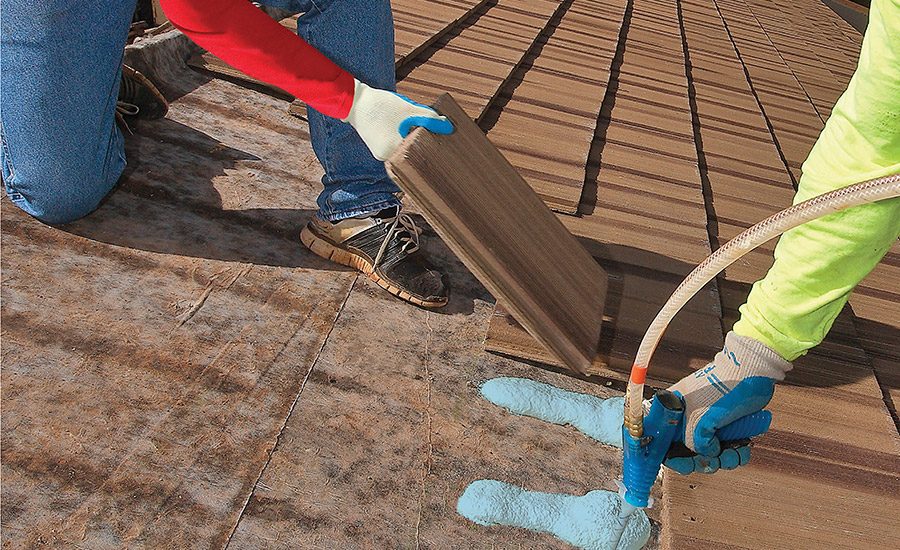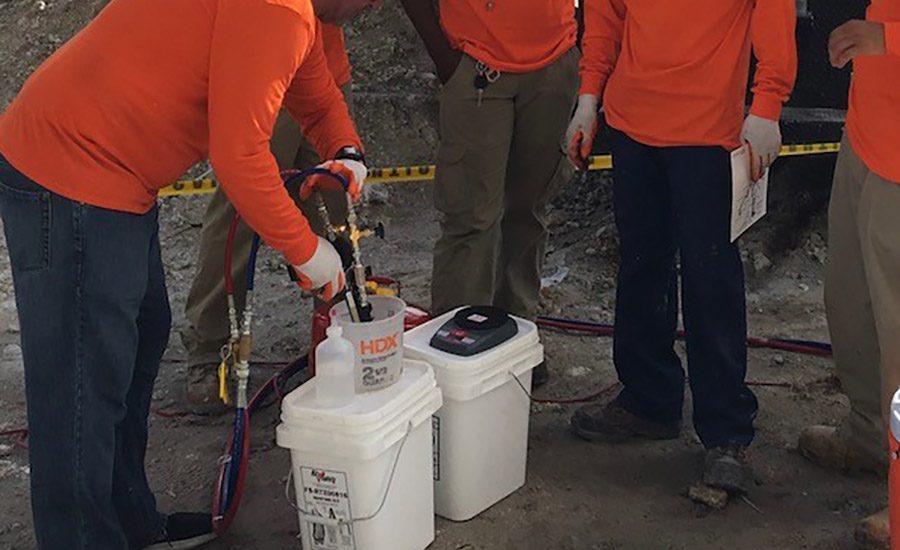Expert Insights for Navigating Single- and Two-Component Roof Tile Adhesives
For concrete and clay tile roof applications, polyurethane foam has emerged as a fast, reliable, and high-performance alternative to mechanical fastening.

Image courtesy of ICP Group.

courtesy of ICP Group

courtesy of ICP Group



There's good reason that tile roofs are a popular option throughout the American sun belt. Not only can they dramatically enhance a home's curb appeal, but they offer outstanding performance and durability. They're particularly popular in hurricane-prone Florida, where their ability to withstand storms and severe weather shines versus asphalt shingles. Indeed, a properly maintained tile roof can offer a 50-to-75-year lifespan depending on where they are installed.
One reason for their performance and longevity in certain markets is the use of modern adhesive technology instead of traditional mechanical fasteners like screws, nails, mortar sets, or wire tires. Adhesives, by contrast to these methods, strongly bond tiles in place. When properly installed by trained professionals, roofs utilizing adhesives can achieve some of the highest possible wind uplift ratings, making them highly advantageous for extreme weather locales in the United States.
But roof tile adhesives can be applied wherever there are concrete and clay tile roofs, elevating performance in any application. And in order to properly advocate for their more widespread use, adhesive professionals should be knowledgeable about the different types of roof tile adhesive options and how they can deliver outstanding performance. In this article, we'll break down the key differences between single-component and two-component roof tile adhesive options, the importance of proper training for applicators, and the many advantages adhesives hold over mechanical fastening methods.
Single-Component Adhesives vs. Two-Component Adhesives
Polyurethane roof tile adhesives can be divided into two primary categories: single-component and two-component.
- In single-component adhesive products, all chemical and raw material components are combined and the adhesive moisture cures upon dispensation.
- Two-component adhesives' adhesion chemistry and other materials are kept separate (A-side/B-side); the chemical reaction begins once the two components are mixed together in the application assembly nozzle. These components are fed through hoses and are combined at the point of application.
While both single- and two-component adhesive options will provide high levels of performance, there are some key differences that may make one more suitable for a given application than the other.
Two-component polyurethane adhesives, for example, maintain the highest available levels of wind uplift performance. Third-party lab testing protocols and adhesive manufacturers' code approvals show higher allowable overturning moment testing data for two-component systems. Depending on the paddy size, tile profile, paddy placement, and gram weight, a properly installed two component adhesive system has the ability to withstand a category five hurricane.
For these reasons, two-component adhesives have been widely used throughout Florida, where hurricane resistance is one of the top priorities for building and construction professionals. Two-component options can also deliver additional tile support, contributing to higher break strength and overall long-term durability. Also, two-component products have higher seismic performance compared to wire-tie applications, making them attractive in areas with regular seismic activity like California.
Single-component options, by comparison, also maintain high levels of performance, but have their own unique advantages in terms of ease of use. Applicators are able to move around the roof area easily since these come in handheld, user-friendly cylinders. Additionally, multiple applicators equipped with individual cylinders can help complete a job more quickly. Single-component systems' portability also lends itself to easier application around hips, ridges, cut pieces, and trim tiles.
One-component systems can also be applied to damp substrates, making it easier to perform work following rain or without waiting for morning dew to evaporate. Finally, one-component adhesives have high yields, enabling contractors to maximize the number of tiles that can be secured with a single tank of product.
Both one-component and two-component polyurethane adhesive systems can bring their own unique advantages to a roofing project. And while the selection of one system over another typically comes down to contractor preferences, adhesive professionals who are armed with the right information on the benefits of each can help guide them to the right choice.
Advantages Over Mechanical Fastening
The use of screws, nails, mortar sets, or wire ties has long been common in tile roof applications. In advocating for the use of high-performing roof tile adhesives in these critical applications, it's important to know about the potential deficiencies of these traditional choices.
First and foremost, using screws or nails to secure tiles inherently involves penetrating the roof deck with thousands of holes. This practice essentially creates greater opportunity for failure in the future than if the roof deck had not been penetrated. Potential issues include water ingress and compromised performance.
Secondly, nails and screws must be applied with the right amount of pressure, without compromising other components. Too loose of an insertion can contribute to future performance issues, particularly in high-wind environments. Conversely, too forceful of an insertion can cause a roof tile to crack or break.
By contrast, securing roof tiles with a high-performance polyurethane adhesive product can functionally eliminate these concerns. Depending on the roof pitch and local building code requirements, roof tile adhesives do not require the installer to puncture the roof deck. Instead, the polyurethane adhesive creates a strong bond between the deck and the tile. This process can also eliminate the variance between a too-tight or too-lose nail or screw insertion and the potential issues associated with each.
The Importance of Certified Application
Getting the most from roof tile adhesives depends not just on the products themselves, but on proper training and installation.
There are two reasons for this. The first is that various building officials, inspectors, and municipalities might require roofing contractors to have been trained in proper product use by the manufacturer. This is particularly true in, once again, areas prone to extreme weather like Florida. Code officials will want to ensure that construction projects completed with adhesive products are being performed by professionals who've been properly trained.
The second reason is simply that a job performed by certified applicators will tend to be more effective and go more smoothly. Adhesives are typically dispensed through convenient and reliable gun/hose assemblies, enabling the installer to spray adhesive and secure tiles quickly and efficiently; an experienced, well-trained crew can complete a typical roof tile job in half the time it takes when utilizing mechanical fasteners. Contractors interested in using roof tile adhesives should seek out manufacturers that provide product-specific training and certifications.
Overall, roof tile adhesives offer a wide range of benefits for tile roof applications. Products that have been formulated for the highest levels of performance and ease of use can contribute to more reliable and more durable roofs — even in the most extreme weather environments — while enabling professionals to work more efficiently and boost their bottom line.
To learn more about roofing tile adhesives visit www.APOC.com. Adrian Robledo can be contacted at arobledo@icpgroup.com.
Looking for a reprint of this article?
From high-res PDFs to custom plaques, order your copy today!




.jpg?height=200&t=1709670950&width=200)



